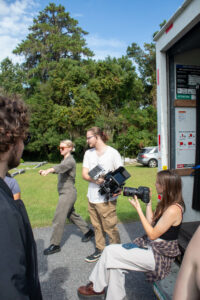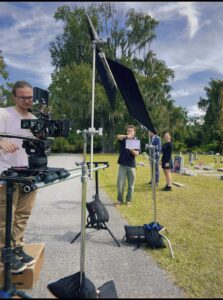As a student filmmaker, finding the funds to bring your vision to life can be one of the most challenging parts of the process. Whether you’re working on your first short film or a more ambitious project, securing financial support is crucial.
As we are currently in the depths of this phase in our upcoming short “Wrong End of the Blade” I wanted to take the change to share ten common ways to get funding. I am including their pros and cons to give you a deeper look into what it is really like to fundraise for student films from the perspective of someone doing it.

1. Grants & Scholarships
Many organizations offer grants and scholarships specifically for student filmmakers. These can often be found through film schools, art foundations, and cultural institutions.
Pros
Grants and scholarships provide free money that doesn’t need to be repaid, adding significant financial support to a project. They often come with additional resources or support and can enhance the credibility and prestige of the film.
Cons
These funding sources are highly competitive, with many applicants vying for limited funds. This can make it difficult to secure funding. The application process is often lengthy and complex, requiring significant time and effort that might not result in success. Additionally, these funds may come with strict usage restrictions, limiting creative freedom, and potentially requiring adjustments to the project.

2. Crowdfunding
Platforms like Kickstarter, Indiegogo, and GoFundMe allow filmmakers to raise money from friends, family, and the general public. A compelling pitch and engaging campaign can attract a broad base of small donors.
Pros
Crowdfunding offers access to a large pool of potential donors and helps build an audience and community around the project. The flexible funding goals allow filmmakers to raise varying amounts depending on the response to their campaign.
Cons
Crowdfunding requires a significant marketing effort to reach and engage potential backers, which can be challenging without a substantial existing network. Platform fees can reduce the total funds raised, cutting into the budget. Additionally, there is no guarantee of success; campaigns may fail to meet their funding goals if they don’t attract enough attention or if the pitch doesn’t resonate with the audience.

3. Film School Funding
Many film schools have funds set aside for student projects. These can be applied for through a competitive process within the school.
Pros
Film school funding is often easier to access for students and is tailored to their specific needs. It may also include mentorship and guidance from experiences faculty members, providing valuable support beyond just financial measures.
Cons
The availability of film school funding is limited and highly competitive within the student body. Additionally, there may be academic requirements or restrictions on how the funds can be used, which can limit the project’s scope and flexibility. If the application is not successful, students may need to seek alternative funding sources.

4. Competitions & Contests
Entering and winning film competitions and contests can provide both funding and exposure. Some competitions offer cash prizes or production resources.
Pros
Entering competitions and contests offers the potential for large cash prizes and provides significant exposure and recognition. Winning or placing in these contests can enhance a filmmaker’s resume and open doors to further opportunities.
Cons
Competitions and contests are very competitive, with many talented filmmakers vying for the same prizes. This can make it difficult to win or place. The application process can be time-consuming and demanding, taking focus away from other aspects of the project. Even if successful, the prize money might not cover the full budget of the film, requiring additional funding sources.

5. Sponsorships & Partnerships
Partnering with local businesses or brands can be a great way to secure funding. In exchange, sponsors might receive advertising opportunities or product placement in the film.
Pros
Securing sponsorships and partnerships can provide substantial funding or resources, building valuable industry connections in the process. These relationships can potentially be long-term, offering ongoing support for future projects.
Cons
Sponsorships may require creative compromises or product placement, which can affect the vision of the film. The process of securing and maintaining sponsorships is time-consuming, and sponsors may have specific expectations or conditions.

6. Personal Savings & Family Support
Many student filmmakers must rely on their own savings or financial support from family members to get their projects off the ground.
Pros
Relying on personal savings and family support provides immediate access to funds without the need for interest or repayment. This method allows for full creative control, as there are no external obligations or conditions.
Cons
This approach is limited by personal or family finances, which may not be sufficient to cover the entire budget of the film. Relying on personal savings can create significant financial strain, potentially impacting other areas of life. Additionally, seeking support from family can lead to personal tension or stress, especially if the project encounters difficulties or if there are differing opinions about the film’s direction.

7. In-Kind Donations
Instead of cash, student filmmakers can often receive goods and services that reduce production costs, such as equipment loans, free locations, or volunteer crew members.
Pros
In-kind donations help reduce overall cash expenses by providing goods and services for free. This method builds goodwill and community support, and filmmakers can secure high-value items or services that might otherwise be unaffordable.
Cons
There may still be a need for cash to cover certain costs that donations cannot address, such as fees for permits or specialized equipment. Coordinating and managing in-kind donations can be challenging, requiring significant logistical effort. The quality of donated goods or services can vary, which might impact the overall production quality if they don’t meet the project’s standards.

8. Fundraising Events
Hosting events such as film screenings, bake sales, or silent auctions can help raise money. These events also serve to build community support and awareness for the project.
Pros
Hosting fundraising events builds community and awareness around the project and can raise significant funds in a short period. These events are fun and engaging for supporters, helping to foster a sense of involvement and excitement.
Cons
Planning and executing fundraising events require significant effort and upfront costs, which can be a burden if the event is not successful. There is no guarantee that the funds raised will meet expectations, potentially leaving financial gaps that need to be filled through other means. Additionally, events can be logistically challenging to organize, requiring coordination and resources that might detract from the film’s production.

9. Government Funding & Tax Incentives
Some governments offer grants, tax incentives, or rebates for film production, including student films. Researching and applying for these can provide significant financial support.
Pros
Like grants, government funding and tax incentives can provide substantial financial support and are often designed to support local filmmakers. These programs may also come with additional benefits or resources that can aid in the production process.
Cons
The application and compliance processes for government funding can be complex and time-consuming, requiring detailed documentation and adherence to specific guidelines. These funds are highly competitive, making it difficult to secure support. Additionally, the funds may come with restrictions or conditions that limit flexibility and require adherence to certain regulations.

10. Alumni Networks & Mentorship Programs
Reaching out to alumni who have gone on to successful careers in the industry can sometimes yield financial support or valuable advice. Alumni networks can also provide connections to potential investors.
Pros
Leverage alumni networks and mentorship programs provides access to experiences industry professionals who can offer significant financial or resource support. These connections can also lead to valuable mentorship opportunities, enhancing both the project and the filmmaker’s career.
Cons
Securing support from alumni networks can be challenging, often requiring a strong pitch or personal connection to attract interest. The level of support might be more limited compared to other funding sources, providing only partial assistance rather than full funding. Building these relationships can take time and effort, which might not always result in immediate financial support or resources.

Navigating the world of film funding as a student filmmaker requires a blend of creativity, persistence, and strategic thinking. Each funding method has its own set of advantages and challenges, and understanding these can help you make more informed decisions. While some strategies may not always work out, exploring a combination of these approaches can increase your chances of securing the financial support needed to bring your film to life. Remember, persistence and adaptability are the key, and every effort brings you one step closer to realizing your creative vision.
We are using many of these tactics to fundraise for our upcoming film “Wrong End of the Blade.” For updates like these and more, keep up to date with our team on our Instagram @5as.productions.

